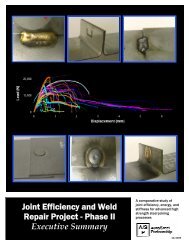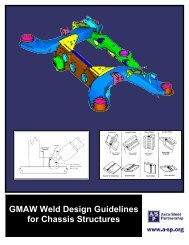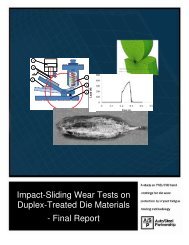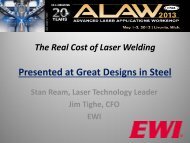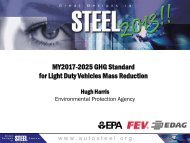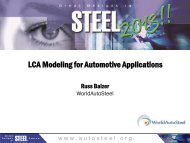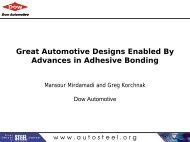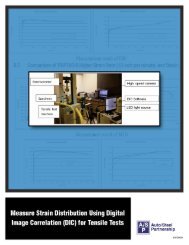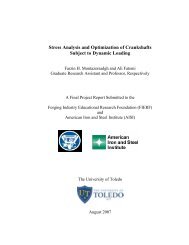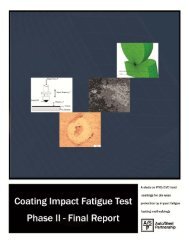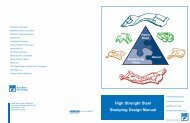Light Truck Frame Joint Stiffness Study Phase 1 Final Report
Light Truck Frame Joint Stiffness Study Phase 1 Final Report
Light Truck Frame Joint Stiffness Study Phase 1 Final Report
You also want an ePaper? Increase the reach of your titles
YUMPU automatically turns print PDFs into web optimized ePapers that Google loves.
APPENDIX A: ABSTRACTS<br />
33. Development of an Automotive <strong>Joint</strong> Model Using an Analytically-Based Formulation<br />
Moon, Y.M. (Michigan University); Jee, T.H. (Korean Passenger Car R&D Center); and Park, Y.P.<br />
(Yonsei University)<br />
Journal of Sound & Vibration, (UK) 4 Mar 1999<br />
A FE model of an automotive structure consists of beam and shell elements. Generally, the pillars<br />
and rockers are modeled as beam elements and other parts as shell elements. Beam elements are<br />
used since they are more efficient than shell elements. A joint is defined as an intersection region of<br />
beam elements, and is generally modeled as coupled rotational springs. In this study, a joint modeling<br />
methodology is presented. First, the definition and assumptions of the joint are discussed. Second,<br />
the joint stiffness analytical model is proposed using static load test results. The proposed method is<br />
more efficient and accurate than existing evaluation methods. Third, the sensitivity analysis method<br />
(Nelson's method) and a joint stiffness updating algorithm are presented. To verify these methods,<br />
the FE analysis results of a half size structural model of an automobile with rigid joints and rotational<br />
spring joints are compared with experimental modal analysis results.<br />
34. Stress Concentration Factors in Tubular K-<strong>Joint</strong>s Under In-Plane Moment Loading<br />
Morgan, M. R. and Lee, M. M. K.<br />
Journal of Structural Engineering; April 1998; v 124<br />
An extensive parametric study is presented of the distributions of stress concentration factors in<br />
tubular K-joints commonly found in offshore platforms. The study covers a comprehensive range of<br />
geometric joint parameters for balanced in-plane moment loading. The results of the study were first<br />
used to assess two sets of widely used parametric equations, which predict the maximum stress<br />
concentration factors on the outer surfaces of the chord and the brace. The new database of finiteelement<br />
results was then used to develop parametric equations for predicting stress concentration<br />
factors at key locations around the intersection on the outer as well as the inner surfaces of the chord.<br />
The reliability of the proposed and existing parametric equations was then assessed using an acrylic<br />
test joint database and some published test data measured from a steel model. Fracture mechanics<br />
fatigue calculations were also performed to demonstrate that the information provided from the<br />
proposed equations could be utilized to obtain accurate, and safe, fatigue life estimates.<br />
35. Design of Extended End-Plate Connections for Hollow Section Columns<br />
Mourad, S.; Korol, R.M.; and Ghobarah, A.<br />
Canadian Journal of Civil Engineering, February 1996<br />
Extended end-plate connections have been widely used in moment-resisting steel frames with W-<br />
shape columns, due to their sufficient stiffness and moment capacity. In addition, such connections<br />
are easy to install and permit good quality control. Extended end-plate connections can also be<br />
employed in moment-resisting frames with hollow structural section columns by using high strength<br />
blind bolts. These bolts have been developed for installation from one side only where the rear side of<br />
the connection is inaccessible. In this study, a quantitative procedure for detailing and designing<br />
beam extended end-plate connections for rectangular hollow structural section columns using high<br />
strength blind bolts is proposed. The design procedure is consistent with the design philosophy given<br />
in limit-state codes. The proposed design is based on the results obtained from an experimental<br />
program and an analytical study.<br />
<strong>Report</strong>: A/SP-005-1 <strong>Light</strong> <strong>Truck</strong> <strong>Frame</strong> <strong>Joint</strong> <strong>Study</strong> 79



